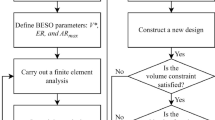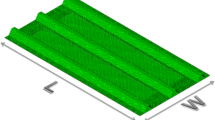Abstract
This paper presents a two-level approximation method for multi-objective optimization of a composite stiffened panel. The purpose is to seek the minimum structural mass and maximum fundamental frequency subject to given displacement constraints and manufacturing limitations. The design variables are the stiffener layout, and laminate stacking sequences for stiffeners and the panel skin. By introducing the concept of ground structure in both stiffener layout and laminate stacking sequence, the design problem is formulated with mixed discrete and continuous variables. Two types of discrete variables represent the existence of each stiffener and the existence of each ply in the laminate, respectively, with continuous ones for ply thicknesses. Considering the objectives are of different dimensions, a weighted min-max objective function is defined and minimized. The problem is firstly made explicit with branched multipoint approximate functions. Genetic algorithm (GA) is then adopted to optimize two types of discrete variables, determining which stiffeners/layers are deleted or retained. For fitness calculation in GA, a second-level approximation is built to optimize continuous ply thicknesses of the necessary layers that are retained. By giving different initial designs of stiffener layout and laminate stacking sequences, reasonable optimization results, which are tradeoffs between the considered two objectives, are obtained as design options. From the number of required structural analysis, it shows that the proposed method has a good efficiency in seeking rational solutions, which are tradeoffs between conflicting objectives and also feasible designs satisfying all considered constraints.








Similar content being viewed by others
References
Abachizadeh M, Tahani M (2009) An ant colony optimization approach to multi-objective optimal design of symmetric hybrid laminates for maximum fundamental frequency and minimum cost. Struct Multidiscip Optim 37(4):367–376
Alinia MM (2005) A study into optimization of stiffeners in plates subjected to shear loading. Thin-Walled Struct 43(5):845–860
An H, Huang H (2017) Topology and sizing optimization for frame structures with a two-level approximation method. AIAA J 55(3):1044–1057
An H, Chen S, Huang H (2015a) Laminate stacking sequence optimization with strength constraints using two-level approximations and adaptive genetic algorithm. Struct Multidiscip Optim 51(4):903–918
An H, Chen S, Huang H (2015b) Improved genetic algorithm with two-level approximation method for laminate stacking sequence optimization by considering engineering requirements. Math Probl Eng 2015:1–13
An H, Xian K, Huang H (2016a) Actuator placement optimization for adaptive trusses using a two-level multipoint approximation method. Struct Multidiscip Optim 53(1):29–48
An H, Chen S, Huang H (2016b) Optimal design of composite sandwich structures by considering multiple structure cases. Compos Struct 152:676–686
Arora JS (2004) Introduction to optimum design. Elsevier, San Diego
Bedair OK (1997) Influence of stiffener location on the stability of stiffened plates under compression and in-plane bending. Int J Mech Sci 39(1):33–49
Chen S, Huang H (2010) Optimum design of a space frame and its application in satellite structure. J Spacecr Rocket 47(6):1063–1066
Chen S, Lin Z, An H, Huang H, Kong C (2013) Stacking sequence optimization with genetic algorithm using a two-level approximation. Struct Multidiscip Optim 48(4):795–805
Faggiani A, Falzon BG (2007) Optimization strategy for minimizing damage in postbuckling stiffened panels. AIAA J 45(10):2520–2528
Fleury C, Braibant V (1986) Structural optimization: a new dual method using mixed variables. Int J Numer Methods Eng 23(3):409–428
Ghiasi H, Pasini D, Lessard L (2009) Optimum stacking sequence design of composite materials Part I: constant stiffness design. Compos Struct 90(1):1–11
Herencia JE, Weaver PM, Friswell MI (2007) Optimization of long anisotropic laminated fiber composite panels with T-shaped stiffeners. AIAA J 45(10):2497–2509
Huang H, Xia RW (1995) Two-level multipoint constraint approximation concept for structural optimization. Struct Optim 9(1):38–45
Huang H, Ke W, Xia RW (1998) Numerical accuracy of the multi-point approximation and its application in structural synthesis. In: 7th AIAA/USAF/NASA/ISSMO Symposium on Multidisciplinary Analysis and Optimization, St. Louis, MO, USA, September 02 – 04, 1998
Huang H, Wang Y, Lian H (2003) Comparisons of several multi-point approximation methods used in structural topology optimization. In: The Chinese conference on computational mechanics ‘2003, Beijing, China, October 1, 2003
Kang JH, Kim CG (2005) Minimum-weight design of compressively loaded composite plates and stiffened panels for postbuckling strength by genetic algorithm. Compos Struct 69(2):239–246
Kirsch U (1989) Optimal topologies of structures. Appl Mech Rev 42(8):223–239
Lanzi L, Giavotto V (2006) Post-buckling optimization of composite stiffened panels: computations and experiments. Compos Struct 73(2):208–220
Le Riche R, Haftka RT (1995) Improved genetic algorithm for minimum thickness composite laminate design. Compos Eng 5(2):143–161
Liu B, Haftka RT, Akgun MA, Todoroki A (2000) Permutation genetic algorithm for stacking sequence design of composite laminates. Comput Methods Appl Mech Eng 186(2-4):357–372
Nagendra S, Haftka RT, Gurdal Z (1993) Design of a blade stiffened composite panel by a genetic algorithm. AIAA Paper 93-1584. In: 34th AIAA/ASME/ASCE/AHS/ASC structures, structural dynamics, and materials conference, La Jolla, CA. p 2418–36
Nagendra S, Jestin D, Gürdal Z, Haftka RT, Watson LT (1996) Improved genetic algorithm for the design of stiffened composite panels. Comput Struct 58(3):543–555
Ohsaki M (1995) Genetic algorithm for topology optimization of trusses. Comput Struct 57(2):219–225
Rikards R, Abramovich H, Kalnins K, Auzins J (2006) Surrogate modeling in design optimization of stiffened composite shells. Compos Struct 73(2):244–251
Seresta O, Abdalla MM, Gurdal Z (2005) Optimal design of laminated composite plates for maximum post buckling strength. AIAA Paper 2005-2128. In: 46th AIAA/ASME/ASCE/AHS/ASC structures, structural dynamics, and materials conference, Austin, Texas. p. 1–12
Todoroki A, Sekishiro M (2008a) Stacking sequence optimization to maximize the buckling load of blade-stiffened panels with strength constraints using the iterative fractal branch and bound method. Compos Part B 39(5):842–850
Todoroki A, Sekishiro M (2008b) Modified efficient global optimization for a hat-stiffened composite panel with buckling constraint. AIAA J 46(9):2257–2264
Walker M (2002) The effect of stiffeners on the optimal ply orientation and buckling load of rectangular laminated plates. Comput Struct 80(27):2229–2239
Wang W, Guo S, Chang N, Yang W (2010) Optimum buckling design of composite stiffened panels using ant colony algorithm. Compos Struct 92(3):712–719
Wang B, Tian K, Hao P, Cai Y, Li Y, Sun Y (2015) Hybrid analysis and optimization of hierarchical stiffened plates based on asymptotic homogenization method. Compos Struct 132:136–147
Yamazaki K (1996) Two-level optimization technique of composite laminate panels by genetic algorithms. AIAA Paper 96-1539. In: 37th AIAA/ASME/ASCE/AHS/ASC structures, structural dynamics, and materials conference, Salt Lake City, UT. p 1882–7
Yong M, Falzon B, Iannucci L (2008) On the application of genetic algorithms for optimising composites against impact loading. Int J Impact Eng 35(11):1293–1302
Acknowledgments
This research work is supported by the National Natural Science Foundation of China (Grant No. 11672016), which the authors gratefully acknowledge.
Author information
Authors and Affiliations
Corresponding author
Rights and permissions
About this article
Cite this article
An, H., Chen, S. & Huang, H. Multi-objective optimization of a composite stiffened panel for hybrid design of stiffener layout and laminate stacking sequence. Struct Multidisc Optim 57, 1411–1426 (2018). https://doi.org/10.1007/s00158-018-1918-2
Received:
Revised:
Accepted:
Published:
Issue Date:
DOI: https://doi.org/10.1007/s00158-018-1918-2




